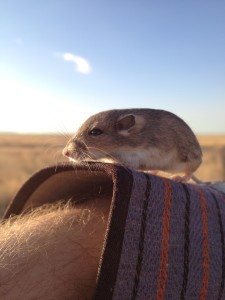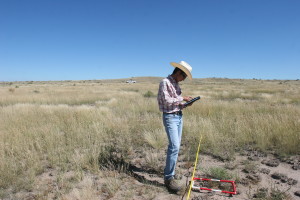A Dixon-funded research project by Sul Ross State University graduate student Bobby Allcorn was featured recently the Big Bend Sentinel and the Aggie News Network from Texas A&M University. Allcorn has been monitoring small rodent populations at Mimms Unit after the Rock House Fire in 2011.
NEWS & EVENTS
Desert rodents rebound after summer rains
MARFA – Rodent researcher Bobby Allcorn had a busy September. Each week the Sul Ross State University graduate student trapped hundreds of small rodents—from petite silky pocket mice to husky wood rats—on the Dixon Ranches Mimms Unit. That’s great news for a host of other wild animals.
“The effects of the Rock House Fire, combined with the drought, devastated the small rodent population,” said Allcorn, whose research is funded by the Dixon Water Foundation, a non-profit that promotes healthy watersheds through sustainable land management. “These animals do rebound with precipitation though. And they’re coming back in force.”

While the drought persists, recent rains have been a boon to small rodents, like this silky pocket mouse found on the Dixon Ranches Mimms Unit near Marfa. (By Bobby Allcorn/Borderlands Research Institute)
In 2011, the Dixon Water Foundation partnered with Dr. Bonnie Warnock of Sul Ross’s Borderlands Research Institute to monitor the small-rodent population on the Mimms Unit. Then the historic Rock House Fire burned most of the ranch on Marfa’s northwest edge.
Without vegetation to eat or hide in, the number of mice and rats crashed, to the point that researchers rarely caught a rodent. The effects ricocheted throughout the food web, from bobcats to quail.
“Predators eat small rodents, so if there aren’t any small rodents, larger animals become prey more often,” Allcorn said. “For example, pronghorn really suffered after the fire. Not only was there no forage for them, but predators went after them more.”
Small rodents play other roles in maintaining healthy grasslands. They disperse seeds and can even alter the plant composition of an area.
“They’re a representation of overall ecological health,” Allcorn said.
Allcorn will finish his small-rodent research next year, at which point he’ll be able to draw more conclusions.
“But for now I can say the population and diversity have certainly increased since last year, due to the rainfall,” Allcorn said. “That’s a great thing for all the other animals and the environment.”
North Texas Land Scholars program slated for July 2014
One of the Dixon Water Foundation’s grant recipients is the North Texas Land Scholars program. This camp, tentatively scheduled for July 13-17, 2014, aims to connect youth to nature by improving their scientific literacy while teaching the value of land stewardship.
Dixon-funded research on soil microbes featured in Texas Wildlife magazine and Big Bend Sentinel
How did the Rock House Fire and 2011 drought affect soil microbes at Mimms Unit? That was the subject of a recent research project by Masahiro Ohnishi, a Natural Resource Management graduate student at Sul Ross State University in Alpine. The Dixon Water Foundation funded Ohnishi’s research, which was featured in “The Road to Recovery” in the July 2013 issue of Texas Wildlife, republished here with permission of the Texas Wildlife Association. Ohnishi’s research was featured previously in the May 16, 2013 issue of the Big Bend Sentinel.
The Dixon Water Foundation breaks ground on Texas’ greenest building

From left to right: Dixon Water Foundation Vice President Clint Josey and wife Betty Josey; Melissa Bookhout, the foundation’s treasurer and office manager; Robert Potts, the foundation’s president and CEO; Robby Tuggle, ranch foreman; Greg Gammill, president of Lincoln Builders; and Tenna Florian, Lake|Flato architect.
DECATUR, MARFA–The Dixon Water Foundation broke ground on June 17 on the Betty and Clint Josey Pavilion, which aspires to be the first “Living Building” in Texas.
The 5,000-square-foot pavilion will be a site for meetings and educational events at the Dixon Ranches Leo Unit in Cooke County. Lake|Flato architects of San Antonio have designed the facility to meet the Living Building Challenge, the most rigorous international green-building certification. Construction is expected to finish later this year.
To meet the standard, the pavilion will generate all of its own clean, renewable energy and capture and treat its own water. Building materials will be non-toxic and sourced responsibly and as locally as possible.
The Living Building Challenge is a natural fit for the Dixon Water Foundation’s mission of promoting healthy watersheds through sustainable land management. The Leo Unit is one of four Dixon Ranches where the foundation demonstrates environmentally and economically sound ways to manage rangeland. The foundation’s other ranches are in Cooke and Parker counties and Marfa, Texas.
The pavilion is named after Clint Josey, the foundation’s vice-president and board chairman, and his wife, Betty. As landowners, the Joseys have been advocates of holistic land management for 30 years.
Click here for a PDF of this press release.
Soil still teems with life after fire, SRSU student finds
MARFA – Two years ago, the Rock House Fire and a record drought scorched most of the Dixon Water Foundation’s Mimms Ranch outside Marfa. The effects aboveground are still obvious, where grasslands are punctuated by patches of barren earth. But how did the fire and drought affect microbes toiling in the soil to create the nutrients grasslands require? This subterranean recovery was studied recently by Masahiro Ohnishi, a Natural Resource Management graduate student at Sul Ross State University in Alpine.
“We wanted to see what kinds of bacteria and archaea are in the soil after the fire and after the drought, and how they recovered from these huge disturbances,” says Ohnishi, whose research was funded by the Dixon Water Foundation, a non-profit that promotes healthy watersheds through sustainable land management.
Bacteria and archaea are single-celled microscopic organisms that are found practically everywhere—from deep-sea vents and arctic glaciers, to cattle intestines and human belly buttons. Many microbes belong to nature’s recycling crew; they break down dead plants and convert them into nutrients required by living plants. Microbes also help create a complex soil texture, which in turn allows seeds to take hold and more rainwater to soak into the ground. All of these functions make soil microbes essential members of a desert grassland ecosystem.
To determine which microbes populate Mimms Ranch, Ohnishi analyzed the microbial DNA in soil samples collected from several unburned, burned and intensely overgrazed sites. Then he used statistical analyses to compare these microbial communities before and after the summer rainy season in 2012. He also looked for correlations with the amount of plant cover, soil nutrients, and other soil characteristics at each study site.
In burned areas, Ohnishi found nearly half as much microbial DNA as in unburned areas, indicating soil microbes had been hit hard by the fire and drought. But microbial activity recovered after the summer rainy season at both burned and unburned sites. Ohnishi observed a corresponding increase in the amount of certain soil nutrients needed by grasses and other plants, which also bounced back after the summer rains.
Ohnishi was particularly amazed by the diversity of soil microbes he encountered. For example, one five-gram soil sample—the weight of a nickel—was home to around 400 types of bacteria.
“There’s so much diversity, and these microbes perform so many functions,” he said. “We have no clue what they all do yet.”
Understanding what each soil microbe does will be up to future researchers. For now, Ohnishi’s research demonstrates that these microbes are part of the recovery process after a devastating fire and drought. And he envisions his research contributing to a micro-ecosystem approach to land management, in which supporting microbial activity would be a way to improve rangeland health.
Bonnie Warnock, associate professor of range science at Sul Ross State University, directed Ohnishi’s research.
“Both the physical and biological health of the soil is critical to healthy ecosystems,” she said. “We tend to take the soil for granted and forget that it is, in a very real way, the base for all life.”
Dixon funds Sul Ross researchers developing cattle for desert
This article in the Big Bend Sentinel describes Sul Ross researchers breeding cattle suited for grazing desert grasslands. Their research was funded by a grant from the Dixon Water Foundation.
Sustainable Cattle Production
One-Day Workshops on Friday, April 12 or Saturday, April 13, 2013.
Join GEARLD FRY and STEVE CAMPBELL for a field day of beef cattle linear measurement.
Where: NCTC Science Bldg. room 407, GAINESVILLE, TX
Time: 9 am – 4 pm
Fee: no fee
Registration required: Limited to the first 12 enrolled. Download the registration form and fax a completed form to 940‐768‐2708 to enroll.
For more information, contact: Melissa Bookhout at mbookhout@dixonwater.org or call 940‐768‐2740
Weatherford Democrat spotlights holistic management at Bear Creek
In Earth Day news, the Weatherford Democrat reports that our work at Bear Creek Unit “sets the standard” for environmentally sustainable ranching.
In “Managing land to protect water,” our Vice President and Board Chairman Clinton Josey describes holistic management as “treating the soil, the plants on the surface, the animals and the ranchers as a whole.”
“It’s a balance, Josey said, and when ranchers consider all the elements, it results in a healthy watershed — the area that drains to a common waterway — and a healthier life for everyone who lives in it.”
Vice President and Board Chairman Clinton Josey described as “treating the soil, the plants on the surface, the animals and the ranchers as a whole.”
It’s a balance, Josey said, and when ranchers consider all the elements, it results in a healthy watershed — the area that drains to a common waterway — and a healthier life for everyone who lives in it.
– See more at: http://www.weatherforddemocrat.com/top-news/x296817186/Managing-land-to-protect-water/#sthash.BuYR3UIe.dpuf
Dixon pledge to pronghorn recovery benefit featured in Alpine Avalanche
From the Alpine Avalanche:
The Dixon Water Foundation of Marfa and the Horizon Foundation of Dallas have pledged up to $50,000 for this weekend’s Pronghorn Restoration Benefit Dinner and Dance.
The Pronghorn Restoration Benefit is scheduled for 6 p.m. Saturday, Jan. 29, at the Granada Theater in downtown Alpine. Local landowners will serving locally grown ribeye steaks with all the fixings; a cash bar will also be available.
The program also includes a silent auction, a brief presentation on pronghorn in West Texas and an outline of the restoration plan. The evening will culminate with a dance featuring Craig Carter and the Spur of the Moment Band.
The pledge comes in the form of a challenge grant where the foundations have committed a dollar to dollar match for up to $50,000 raised during the benefit.
The benefit is spearheaded by the Trans-Pecos Pronghorn Working Group made up of local ranchers, conservationists and researchers with the Borderlands Research Institute at Sul Ross State University who are concerned with the recent demise of pronghorn in the region. Figures put the population at an all-time low of 4,800. The Pronghorn Working Group has helped implement a series of investigations into the pronghorn decline.


